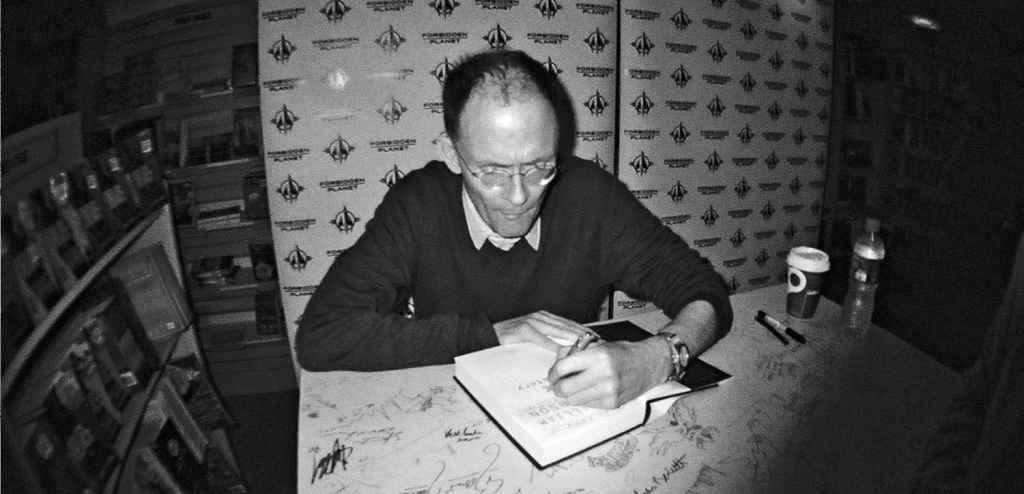William Gibson’s 2003 novel Pattern Recognition was a return to form in many regards. While never critically derided, Gibson’s output throughout the 90s was noticeably- and decidedly- a distinct turn from his work in the 1980s.
Gibson burst onto the literary scene with 1984’s Neuromancer, a cyberpunk fever dream set partially in the grimy neon lit sprawl of the fictional Chiba City. Gibson followed Neuronmancer with Count Zero in ’86 and Mona Lisa Overdrive in ’88, rounding out his first trilogy, known as the ‘Sprawl’ trilogy. Although not explicitly related, Gibson’s first three books shared the same world, themes and a few characters. Writing in thematically related trilogies with varying degrees of interconnectivity would become Gibson’s hallmark, a trend that continues to this day as we eagerly await the third book in his highly regarded ‘Jackpot’ trilogy.

Having been almost being single handedly responsible for the cyberpunk aesthetic as we now know it, to the point where he coined the term ‘cyberspace’ in his 1982 short story Burning Chrome, one would expect that Gibson would continue to flesh out the themes and aesthetic that he created. However, Gibson began the 90s with a collaboration with Bruce Sterling. The Difference Engine would be a prototype of the Steampunk aesthetic set in an alternate history Victorian London.

In the 90’s Gibson’s second trilogy moved away from cyberpunk and instead explored the sociological developments of near-future urban environments, postindustrial society, and late stage capitalism. Vitual Light (1993), Idoru (1996), and All Tomorrow’s Parties (1999) rounded out his Bridge trilogy.
“Always an underground sensation, it wasn’t until the 2000’s that Gibson would finally land on best-seller lists for the first time.”
Gibson’s work in the eighties gave him the status as a kind of ‘cyperpunk prophet’, a status that he is quick to denounce, whose insights were seen as a predictor of new tech trends into the 1990s and beyond. This status was further cemented throughout the 90s and 2000s when his non-fiction work began to frequently appear in the pages of Wired Magazine, an outlet that at the time was seen as the ultimate intersection of all that was bleeding-edge in tech and cool.

Always an underground sensation, it wasn’t until the 2000’s that Gibson would finally land on best-seller lists for the first time with his Blue Any trilogy, beginning in 2003 with Pattern Recognition, and following that critical and commercial success with Spook Country (2007) and Zero History (2010).

It was, however, 2003’s Pattern Recognition that provided a very specific and unexpected influence. The novel details the exploits of “cool hunter” Cayce Pollard’s pursuit to uncover the origin of a series of mysterious viral internet videos at the behest of a morally-questionable marketing executive. Crafted into the complex plot are references to the secretive and cult-like phenomenon of imitative Japanese fashion, specifically a reproduction of a 1950s military bomber jacket the protagonist, Pollard, is infatuated with.
In Gibson’s own words, from a 2004 blog post:
“A Korean friend of mine told me about buying a Rickson’s jacket in Tokyo. My friend is a multi-lateral otaku, and once had an office-mate in Seoul who collected nothing but the *zippers* from US military flight jackets. *That* impressed me. So my friend told me about the trouble he’d gone to to score a Buzz Rickson’s repro of a WWII US Navy N-1 deck jacket. I Googled Rickson’s, couldn’t read the kanji, but saw these hyper-obsessive MA-1 repros.
The MA-1 is a very complexly iconic garment, having manifested in a number of subcultures since its initial military issue in the 50s. A tiny cult of proto-Mods favored it early-Sixties Soho, skinheads made it a part of their intensely narrow dress-code (often in burgundy, which the USAF never issued either), it was part of a certain gay uniform, goths wore it (always in black). And I had always liked it, particularly on girls. I had never been able to wear one, myself, because they tend to be cut very short in the back, and I have a very long back.”
Buzz Ricksons is indeed a real clothing company. Their website lists them as being in business since 1993, with the brand name being taken from Steve McQueen’s character in the 1961 movie ‘The War Lover’. They sell carefully created and methodically constructed garments reproduced from 1940-1960s era military clothing such as jackets, sweaters and trousers- all at a premium label price.

While many jackets have been made using the MA-1 pattern over the years, Cayce Pollard’s specific black Buzz Ricksons MA-1 bomber jacket was a fictional creation by Gibson. According to Gibson, shortly after the book’s release he received a letter from a puzzled Buzz Ricksons employee stating the company was being inundated with requests for a black MA-1, with customers citing Gibson’s book as the inspiration.
What followed was a collaboration between William Gibson and Buzz Ricksons with release of a special Pattern Recognition model of the MA-1, in black of course. According to Gibson no money changed hands; Gibson simply requested they cut one with four extra inches in the back and send it his way.

Leave a comment